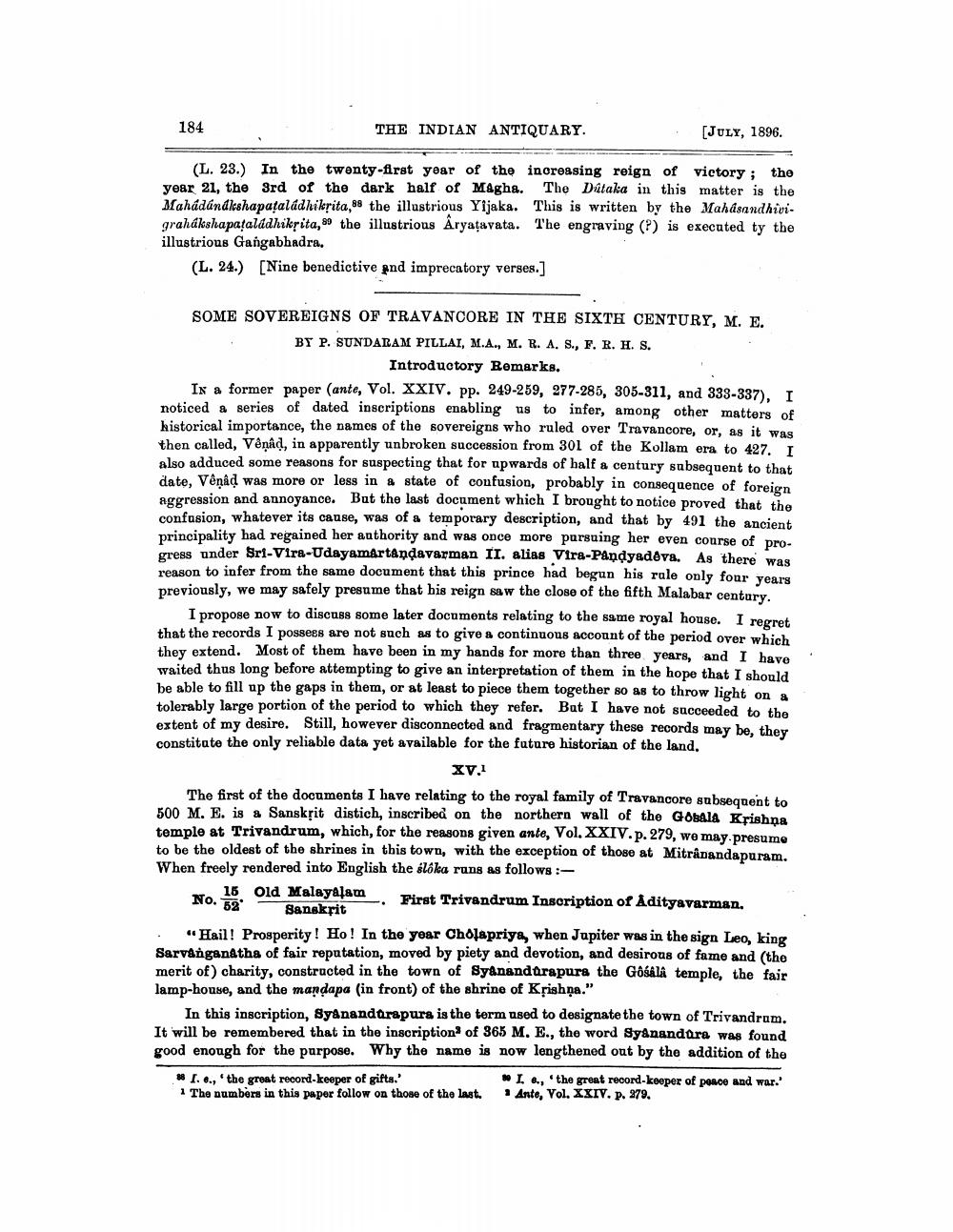________________
184
THE INDIAN ANTIQUARY.
[JULY, 1896.
(L. 23.) In the twenty-first year of the increasing reign of victory; the year 21, the 3rd of the dark half of Magha. The Ditaka in this matter is the Mahádándleshapataladhikrita,88 the illustrious Yijaka. This is written by the Mahasandhivi. grahákshapatalddhikṣita, S9 the illustrious Aryatavata. The engraving (?) is executed ty the illustrious Gangabhadra.
(L. 24.) [Nine benedictive gnd imprecatory verses.]
SOME SOVEREIGNS OF TRAVANCORE IN THE SIXTH CENTURY, M. E. BY P. SUNDARAM PILLAI, M.A., M. R. A. S., F. R. H. S.
Introductory Remarks. Is a former paper (ante, Vol. XXIV. pp. 249-259, 277-285, 305-311, and 333-337). I noticed a series of dated inscriptions enabling us to infer, among other matters of historical importance, the names of the sovereigns who ruled over Travancore, or, as it was then called, Vêņâd, in apparently unbroken succession from 301 of the Kollam era to 427. I also adduced some reasons for suspecting that for upwards of half a century subsequent to that date, Venad was more or less in a state of confusion, probably in consequence of foreign aggression and annoyance. But the last document which I brought to notice proved that the confusion, whatever its cause, was of a temporary description, and that by 491 the ancient principality had regained her authority and was once more pursuing her even course of progress under Sri-Vira-Udayamartandavarman II. alias Vira-Pandyadova. As there was reason to infer from the same document that this prince had begun his role only four years previously, we may safely presume that his reign saw the close of the fifth Malabar century.
I propose now to discuss some later documents relating to the same royal house. I regret that the records I possess are not such as to give a continuous account of the period over which they extend. Most of them have been in my hands for more than three years, and I have waited thus long before attempting to give an interpretation of them in the hope that I should be able to fill up the gaps in them, or at least to piece them together so as to throw light on a tolerably large portion of the period to which they refer. But I have not succeeded to the extent of my desire. Still, however disconnected and fragmentary these records may be, they constitute the only reliable data yet available for the future historian of the land.
XV.1 The first of the documents I have relating to the royal family of Travancore subseqnent to 500 M. E. is & Sanskrit distich, inscribed on the northern wall of the GOBAJA Krishna temple at Trivandrum, which, for the reasons given ante, Vol. XXIV. p. 279, we may presume to be the oldest of the shrines in this town, with the exception of those at Mitranandapuram. When freely rendered into English the slóka runs as follows:
15 Old Malayalam First Trivandrum Inscription of Adityavarman.
No. 52
-
Sanskrit
"Hail! Prosperity ! Ho! In the year Cholapriya, when Jupiter was in the sign Leo, king Sarvanganaths of fair reputation, moved by piety and devotion, and desirous of fame and (the merit of) charity, constructed in the town of Syanandarapura the Gośála temple, the fair lamp-house, and the mandapa (in front) of the shrine of Krishna."
In this inscription, Syanandtrapura is the term used to designate the town of Trivandrum. It will be remembered that in the inscription of 365 M. E., the word Syanandura was found good enough for the purpose. Why the name is now lengthened out by the addition of the
* I..., 'the great record-keeper of gifts.' 1 The numbers in this paper follow on those of the last.
I , the great record-keeper of peace and war.' Ante, Vol. XXIV. p. 279.




